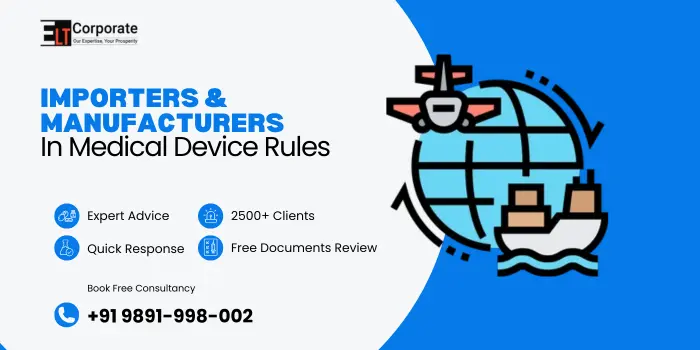The CDSCO created the Medical Device Regulations, 2017, under the Drugs and Cosmetics Act of 1940 to make sure that medical goods marketed in India are safe, of good quality, and work well. To meet these rules, importers and manufacturers need to know what their tasks and duties are. These groups all have various jobs to make sure that only safe, effective, and licensed medical equipment gets to the Indian market. This page goes over the regulations for importers and manufacturers under the Medical Device Regulations, 2017. It talks about things like regulatory responsibilities, differences, paperwork, and compliance demands.
What Does a Manufacturer Have to Do Under the Medical Device Rules, 2017?
A manufacturer is in charge of designing, making, testing, packing, and labelling medical products. The manufacturer guarantees that all of the equipment meets the key Safety and performance principles set forth in Chapter V of the Rules.
- Get a manufacturing licence (Form MD-5) from the State Licensing Authority (SLA).
- Do a risk analysis, a clinical assessment, and a product validation.
- Follow Rule 44 for correct labelling, which includes UDI (Unique Device Identification).
- Tell the CDSCO about bad incidents and work with them during inspections or recalls.
What an Importer Has to Do Under the Medical Device Rules of 2017
An importer is needed to bring certified medical gadgets into India from producers in other countries. The importer is a link between international businesses and Indian authorities that makes sure the rules are followed.
- Get an Import Licence (Form MD-15) from an Indian agent who is allowed to do so.
- Send all of the foreign manufacturer’s device master files (DMF) and plant master files (PMF).
- Ensure that the foreign manufacturer holds a valid ISO 13485:2016 certification.
- Check if the gadgets fall into one of the four Indian categories (Class A, B, C, or D) under the MDR 2017.
- Check that it meets the requirements for labelling, storage, and distribution.
- Inform post-market monitoring data and organise the recall of the product.
Roles of Importers and Manufacturers under the Medical Device Rules, 2017
Aspect: Manufacturer, Importers, License Type: Manufacturing License (Form MD-5)
- Form MD-15 for an import licence
- The State Licensing Authority (SLA) and the Central Licensing Authority (CDSCO) are responsible for issuing licenses.
- Main Purpose
- Makes and puts together medical devices
- Brings in and sells products produced in other countries
- ISO 13485:2016 states that the quality system must comply with it.
- Make sure that the foreign producer has ISO 13485 certification
- Required Documents: Device Master File, QMS, Risk Assessment, Device Master File, Plant Master File, and Free Sale Liability for the certificate
- In charge of the quality of the product
- In charge of making sure that imported goods match Indian norms
- Market Role: Provides goods to hospitals, wholesalers, and customers
- Brings gadgets that have been accepted into the Indian market
What kinds of permits do importers and manufacturers need to follow the Medical Device Rules, 2017?
The medical device laws of 2017 say that importers and producers need the following licence:
- Entity Required License Application Form Approval Form Issued By Authority Manufacturer Manufacturing License Form MD 3 Form MD 5 Importer Import License Form MD 14 Form MD 15
- Both licenses guarantee that medical devices are made or brought into the country under tight government rules for safety, quality, and traceability.
What kinds of paperwork do producers and importers need?
For People Who Make Things:
- Letter of Application and Cover Letter
- Master File for the Site and Master File for the Device
- Certificate for ISO 13485:2016
- Reports on the calibration and validation of equipment by technical staff
- Requirements for labelling and packaging
- For those who bring things in:
- Power of Attorney from the foreign manufacturer, ISO 13485 Certificate of the production site, Free Sale Certificate (FSC) from the country of origin Device Master File (DMF) and Plant Master File (PMF), examples of labels and instructions for use (IFU)
- Information about the Indian Authorised Agent
- Under MDR 2017, CDSCO sorts medical devices for manufacturers and importers.
Class Risk Level Examples
Class A
- Low Risk: Thermometers and surgical dressings
Group B
- Class C: Low to Moderate Risk Suction Equipment and Needles
- Dialysis machines and ECG machines are at a moderate to high risk.
- Class D High Risk Heart Valves and Pacemakers
What happens to importers and manufacturers if they don’t follow the Medical Device Rules, 2017?
Read the points to find out how the medical device laws of 2017 impact importers and manufacturers who don’t follow them: –
- Rule 35 says that a license may be suspended or cancelled.
- The CDSCO may take back or seize products.
- The Drugs and Cosmetics Act of 1940 says that people may be punished and prosecuted.
- Hurt the brand’s reputation and confidence in the market.
- So, it is very important for both producers and importers to be honest, keep records, and be open about their business methods.
Do both Importers and Producers have to have ISO 13485 Certification?
Yes, both must be ISO 13485 certified to make sure that medical devices have the right quality management systems.
Under MDR 2017, can a business be both an importer and a manufacturer?
Yes, but each function has its own licence, and each activity must fulfil its own compliance requirements.


Comments are closed